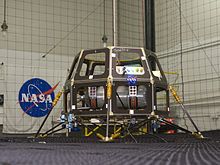Odyssey Moon
This article needs to be updated. (July 2016) |
On 6 December 2007, Odyssey Moon was the first team to register for the Google Lunar X Prize competition,[1] an event that hopes to rekindle the efforts of humans to return to the Moon. The competition is referred to as "Moon 2.0" and is composed of other private organizations like Odyssey Moon Limited, the commercial lunar enterprise that makes up this team.[2] Each team will be competing for a $20 million first prize, a $5 million second prize, and additional $5 million in (potential) bonuses.[3]

Odyssey Moon Limited is based on the Isle of Man,[2] and is the design of Robert D. Richards.[3] His goals include developing the first commercial enterprise that utilizes the energy and resources on the Moon.[6] To achieve this end, the team enlisted the part-time consultant services of Alan Stern, NASA's former top-rank planetary scientist.[7] On 22 September 2008, another veteran of NASA joined Odyssey Moon. Jay F. Honeycutt was named president and will be responsible for all programs and commercial launch operations. He brings a great deal of expertise in managing large scale engineering operations. His experience at NASA was diverse. He was director of the Kennedy Space Center for several years and was director of Shuttle Management and Operations for more than five years. Outside NASA, another part of his forty years of professional experience was as president of Lockheed Martin Space Operations from 1997-2004.[8][needs update]
The team's goals are to build and deploy a robotic lander that will deliver exploration as well as scientific payloads to the Moon. The new lander/spacecraft has been dubbed "MoonOne (M-1)".[9] These efforts have been contracted to MacDonald Dettwiler, a Canadian corporation with a successful history of providing technical space solutions for several NASA projects including the Space Shuttle and the International Space Station.[2][needs update]
The Planetary Society, an international space interest group co-founded by Carl Sagan, joined Odyssey Moon's efforts in 2007, specifically with public outreach and coordination between public and private organizations.[1]
Colin Pillinger, a scientist with a background in studying meteorites, led the European Space Agency's failed Beagle 2 Mars lander project in 2003. In 2009 he was in discussion with Odyssey Moon regarding the use of an identical version of Beagle's most powerful instrument on their lander.[4][needs update]
See also
[edit]References
[edit]- ^ a b Leonard David (2007). "Private Company Accepts Google Lunar X Prize Challenge". Space.com. Retrieved 3 August 2010.
- ^ a b c "Odyssey Moon first off the mark for the Google Lunar X PRIZE". space.co.uk. Archived from the original on 17 January 2008. Retrieved 6 February 2008.
- ^ a b "Odyssey Moon Announced as First Official Competitor in the Google Lunar X PRIZE". googlelunarxprize.org. Archived from the original on 16 September 2007. Retrieved 6 February 2008.
- ^ a b Craig Covault (2009). "Moon beckons commercial comeback for Beagle". Spaceflight Now. Retrieved 3 February 2010.
- ^ "Odysseus moon lander still operational, in final hours before battery dies". 28 February 2024.
- ^ "Reaching for the moon: Interview with Robert Richards". CNN. 9 May 2008. Retrieved 25 June 2008.
- ^ "Former NASA chief Alan Stern joins Odyssey Moon" (PDF). Odyssey Moon. Archived from the original (PDF) on 10 October 2008. Retrieved 16 July 2008.
- ^ "Former NASA Kennedy Space Center Director Jay Honeycutt Announced As President of Odyssey Moon U.S. Operations". spaceref.com. 22 September 2008. Retrieved 22 September 2008.
- ^ Dave Mosher; Anthony Duignan-Cabrera (21 February 2008). "Private race to the moon (and money) takes off". Space.com. Archived from the original on 30 July 2014. Retrieved 22 February 2008.
